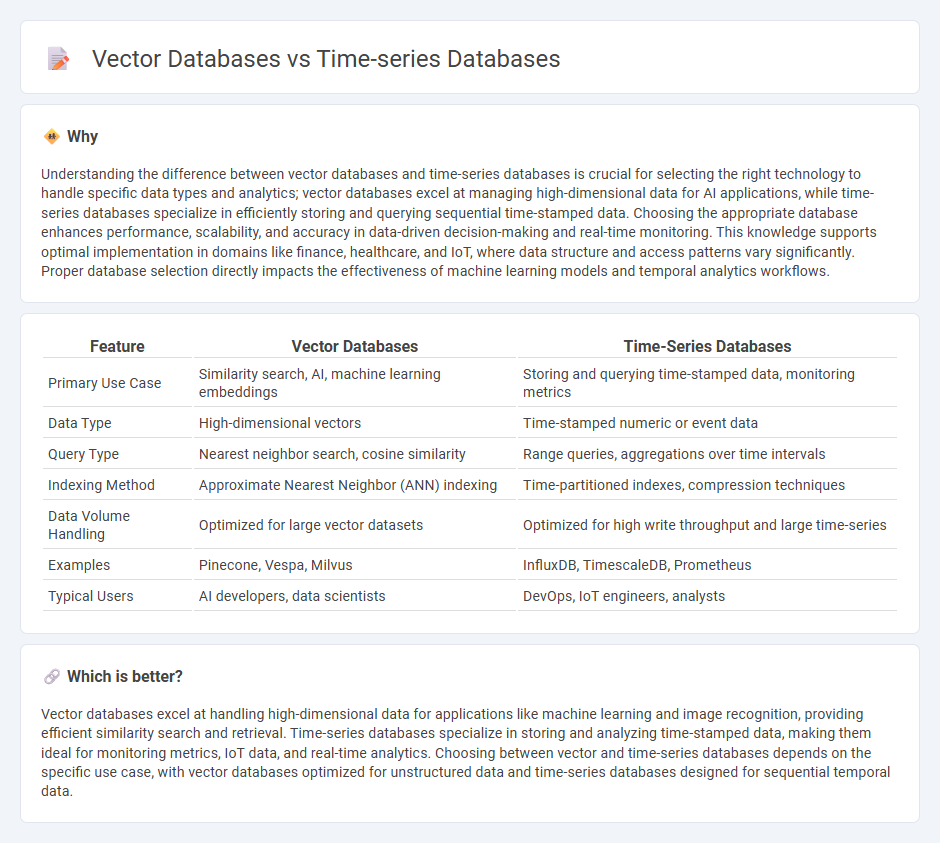
Vector databases excel in managing high-dimensional data for applications like machine learning and image recognition, enabling rapid similarity searches. Time-series databases specialize in handling data points indexed over time, making them ideal for monitoring system performance, financial analysis, and IoT sensor data. Explore the distinctions and use cases to determine which database technology best suits your project needs.
Why it is important
Understanding the difference between vector databases and time-series databases is crucial for selecting the right technology to handle specific data types and analytics; vector databases excel at managing high-dimensional data for AI applications, while time-series databases specialize in efficiently storing and querying sequential time-stamped data. Choosing the appropriate database enhances performance, scalability, and accuracy in data-driven decision-making and real-time monitoring. This knowledge supports optimal implementation in domains like finance, healthcare, and IoT, where data structure and access patterns vary significantly. Proper database selection directly impacts the effectiveness of machine learning models and temporal analytics workflows.
Comparison Table
| Feature | Vector Databases | Time-Series Databases |
|---|---|---|
| Primary Use Case | Similarity search, AI, machine learning embeddings | Storing and querying time-stamped data, monitoring metrics |
| Data Type | High-dimensional vectors | Time-stamped numeric or event data |
| Query Type | Nearest neighbor search, cosine similarity | Range queries, aggregations over time intervals |
| Indexing Method | Approximate Nearest Neighbor (ANN) indexing | Time-partitioned indexes, compression techniques |
| Data Volume Handling | Optimized for large vector datasets | Optimized for high write throughput and large time-series |
| Examples | Pinecone, Vespa, Milvus | InfluxDB, TimescaleDB, Prometheus |
| Typical Users | AI developers, data scientists | DevOps, IoT engineers, analysts |
Which is better?
Vector databases excel at handling high-dimensional data for applications like machine learning and image recognition, providing efficient similarity search and retrieval. Time-series databases specialize in storing and analyzing time-stamped data, making them ideal for monitoring metrics, IoT data, and real-time analytics. Choosing between vector and time-series databases depends on the specific use case, with vector databases optimized for unstructured data and time-series databases designed for sequential temporal data.
Connection
Vector databases and time-series databases both optimize data retrieval and analysis by structuring information in formats suited for specific query types; vector databases excel in handling high-dimensional data for machine learning and AI applications, while time-series databases specialize in timestamped data for tracking changes over intervals. Both databases leverage indexing techniques like approximate nearest neighbor (ANN) search in vector databases and time-based partitioning in time-series databases to enhance query efficiency. Integrating vector embeddings with time-series data enables advanced analytics such as anomaly detection and predictive maintenance across temporal and spatial dimensions.
Key Terms
Temporal Data Indexing
Time-series databases excel in handling temporal data indexing by organizing data points chronologically with high write throughput and efficient time-based queries. Vector databases, while optimized for high-dimensional similarity searches, typically lack native temporal indexing capabilities essential for time-series analytics. Explore detailed comparisons to understand how temporal data indexing impacts your choice between time-series and vector databases.
Similarity Search
Time-series databases optimize storage and retrieval of sequential data indexed by time, enabling efficient queries on trends and patterns. Vector databases specialize in similarity search by indexing high-dimensional vectors to rapidly find nearest neighbors using metrics like cosine similarity or Euclidean distance. Explore the nuances of how each database supports similarity search to choose the ideal solution for your data-driven applications.
Data Ingestion Patterns
Time-series databases excel at handling continuous, high-velocity data ingestion with time-stamped entries, making them ideal for monitoring IoT devices, financial tick data, and sensor outputs. Vector databases specialize in large-scale ingestion of high-dimensional data vectors, supporting applications in machine learning, similarity search, and recommendation systems through efficient indexing and real-time updates. Explore the nuances of data ingestion patterns in time-series vs. vector databases to optimize your storage and query strategies.
Source and External Links
What Is A Time Series Database? How It Works & Use Cases - This webpage provides an overview of time-series databases, including their functionality for storing and retrieving timestamped data efficiently.
The Best Time-Series Databases Compared - This article compares several leading time-series databases, highlighting key features and criteria for selecting the best one for specific applications.
Time series database - This Wikipedia page offers a comprehensive overview of time-series databases, including their design and use in storing and serving time-stamped data.
 dowidth.com
dowidth.com